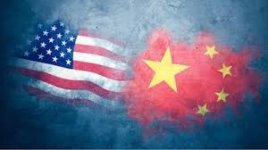Tensions between the United States and China have once again affected the global economy. Stock markets around the world fell by about 4 to 5 percent after U.S. President Donald Trump announced a 145% tariff on Chinese goods. This trade war between the world’s two largest economies is growing day by day, and there seems to be no easy solution in sight.Earlier, Trump had announced that there would be no new tariffs for the next 90 days—but this relief was only for countries other than China. Investors were hopeful, and the stock markets went up by 12% after his announcement. But things changed quickly when Trump added an extra 20% tariff on Chinese products, blaming China for sending illegal Fentanyl drugs into the U.S. Fentanyl is a highly dangerous drug, responsible for many deaths in America, and the U.S. holds China responsible for its supply.China, on the other hand, reacted strongly.
It raised tariffs on U.S. goods by 84% and warned of more actions in the future. Chinese officials said they are ready for talks, but only if they are treated with equality and respect. They accused the U.S. of damaging the global trade system and said that China will firmly defend its national interests.Even under pressure, China is not stepping back. One reason is that Chinese President Xi Jinping seems fully prepared for such a situation. Chinese media is showing a strong message that the country is ready to face any challenge, and its people expect their leaders to stay strong in front of foreign pressure. In recent years, China has reduced its trade dependence on the U.S. In 2018, about 20% of China’s exports went to the U.S., but now it's only 15%. Imports from the U.S. have also decreased.Chinese companies are also shifting their factories to other countries like Vietnam and Cambodia to avoid U.S. tariffs.
At the same time, China is investing heavily in high-tech sectors like artificial intelligence, semiconductors, and robotics. Companies such as Huawei and DeepSeek are part of China's long-term plan to become self-reliant in key technologies. The government has supported this growth by giving financial help and policy support.President Xi is not just thinking short-term. He is looking at the bigger picture—China wants to compete with the U.S. not just in trade, but as a global power. This is not just a trade war anymore; it has become a struggle for global leadership. Both countries contribute nearly 40% of the world’s economy, so when they fight, the whole world is affected.In conclusion, it is clear that both the U.S. and China are ready for a long and tough battle. Neither side wants to appear weak. While the U.S. continues to pressure China, Beijing is showing that it has its own plan and the strength to fight back. This fight may continue for years, and its impact will be felt far beyond just these two countries.
It raised tariffs on U.S. goods by 84% and warned of more actions in the future. Chinese officials said they are ready for talks, but only if they are treated with equality and respect. They accused the U.S. of damaging the global trade system and said that China will firmly defend its national interests.Even under pressure, China is not stepping back. One reason is that Chinese President Xi Jinping seems fully prepared for such a situation. Chinese media is showing a strong message that the country is ready to face any challenge, and its people expect their leaders to stay strong in front of foreign pressure. In recent years, China has reduced its trade dependence on the U.S. In 2018, about 20% of China’s exports went to the U.S., but now it's only 15%. Imports from the U.S. have also decreased.Chinese companies are also shifting their factories to other countries like Vietnam and Cambodia to avoid U.S. tariffs.
At the same time, China is investing heavily in high-tech sectors like artificial intelligence, semiconductors, and robotics. Companies such as Huawei and DeepSeek are part of China's long-term plan to become self-reliant in key technologies. The government has supported this growth by giving financial help and policy support.President Xi is not just thinking short-term. He is looking at the bigger picture—China wants to compete with the U.S. not just in trade, but as a global power. This is not just a trade war anymore; it has become a struggle for global leadership. Both countries contribute nearly 40% of the world’s economy, so when they fight, the whole world is affected.In conclusion, it is clear that both the U.S. and China are ready for a long and tough battle. Neither side wants to appear weak. While the U.S. continues to pressure China, Beijing is showing that it has its own plan and the strength to fight back. This fight may continue for years, and its impact will be felt far beyond just these two countries.

